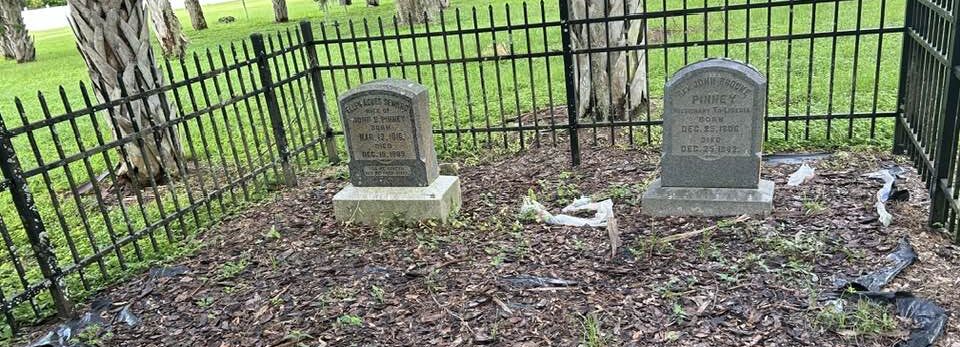Montague, Florida — Where the Dead Still Speak Softly

Tucked behind the suburban hush of Ocala’s cul-de-sacs, beneath layers of concrete and curated lawns, lies the ghost of Montague — not the tragic lover, but a once-breathing town that now lingers only in memory and moss-covered gravestones.
Montague doesn’t shout its story. It hums it. Low and steady, like a hymn carried on hot wind through the pines. You won’t find ruins here or haunted halls — only a quiet road near Hwy 464, a name on a map most folks don’t bother to trace. But those who do? They step back into a time when Florida was less neon and more raw, when 100 souls made a town, when a reverend and his mission carved meaning into the wild.
This is not a ghost town of theatrical decay. This is the kind where the ghosts have manners, nod politely from porches that no longer stand, and whisper their stories through pine needles and gravel driveways.
And in the middle of it all, two graves. The last true markers of a place once called Montague.
The Life and Legacy of Rev. John Brooke Pinney — Montague’s Missionary Soul
Long before the quiet suburb sprouted sidewalks and backyard grills, Montague was a mission field — not of conquest, but of conviction. And its most enduring echo? A man named John Brooke Pinney, whose life spanned oceans, sermons, heartbreak, and hope.
Born in Baltimore in 1806, Pinney was a child of destiny — his bloodline traced back to Lt. Abraham Pinney, his mind sharpened young at Windsor Academy, and his soul struck like flint at a revival meeting that sent him down a road his father never wished for him.
That road led him across the sea to Liberia, where the American Colonization Society had etched out a fragile foothold for freed Black Americans and hopeful missionaries. By 1835, Pinney was acting governor there — not out of ambition, but necessity. He battled tropical illness, cultural collision, and the grind of idealism under heat and hardship. But he stayed. And when he returned to the U.S., he did so not in retreat, but as Liberia’s voice — its Consul General, its advocate, its weary yet unwavering friend.
In 1879, that long, burdened path finally led him here — to a patch of land in Marion County where the pines whispered peace and possibility. He bought 240 acres. Built a small school. A church. A home for his mission, and maybe — finally — for himself.
But fate would not linger long. Pinney died on Christmas Day, 1882, leaving behind more legacy than footprint. His funeral was attended mainly by the Black community he had served — a quiet testament to the bridges he built, the hearts he reached, the town he helped shape.
Today, only two stones remain to tell his tale — his and that of his wife, Ellen Agnes Seward. Restored and standing alone, their graves are not just markers. They are memory anchors, holding Montague’s story in place as the world moves on around them.
For more details on Reverend Pinney’s journey and the Shakespearean Ghost Towns of Capulet & Montague, watch my video below:
Montague in the Late 1800s — The Brief Bright Pulse of a Vanishing Town
Montague never asked to be famous. It simply was — a small, steadfast pulse in Florida’s post-Civil War bloom. Born of fertile soil and whispered dreams, the town grew like so many others did back then: quietly, earnestly, stitched into the patchwork of the American South.
By 1911, maybe a hundred people called it home. A general store stood like a heart at the center — selling everything from tin nails to tinned peaches. A post office carried letters to and from the rest of the world from 1886 to 1915, each envelope a small act of hope, a tether to life beyond the pine line.
But it wasn’t just commerce that held Montague together. It was connection — to each other, and to the land. Rev. Pinney’s church and school added a sacred rhythm to the days, drawing in freedmen, settlers, and dreamers alike. The town’s social fabric was deepened by these bonds — threads spun from resilience, faith, and fresh starts.
Then came the railroad — that iron artery of progress — pulsing through the region and giving Montague a shot of momentum. Citrus, timber, and trade moved faster, farther. For a moment, it seemed the little town might bloom brighter.
But progress has a price. And it doesn’t always pay it where you expect.
The Decline and Transformation of Montague — Where Memory Yields to Manicured Lawns
Montague didn’t fall in fire or flood. It simply faded — the way a voice does when the room forgets to listen.
The 20th century came, and with it, the slow unraveling. Agriculture shifted. Trade routes evolved. The post office closed its doors in 1915, no longer needed. Citrus froze. Storms came and went, tearing at the seams of small-town life. And piece by piece, the world moved on.
The fairgrounds were sold. The land — once home to sermons, harvests, and schoolhouse lessons — was parceled, paved, and renamed. The Magnolias, they call it now. A name soft as petals and twice as misleading.
Today, Montague is a quiet Ocala neighborhood, home to a thousand souls who likely never heard of Rev. Pinney or the letters that once passed through a humble post. Suburbia has replaced the past with symmetry. Fences stand where rail ties once ran. The sacred is hidden in the soil.
But not entirely lost.
The graves remain — small, defiant testaments beneath the sky. Two stones. Two names. A reminder that the ground beneath your feet once beat with different footsteps. That history doesn’t vanish. It just settles deeper.
Tips for Visiting Montague Today — Walking Softly Through What Remains

Don’t expect creaking saloon doors or boarded-up schoolhouses. Montague’s ghosts don’t wear costumes. They linger instead in the hush — in cul-de-sacs built over furrowed fields, in silence where voices once gathered.
If you go (and you should), begin at the graves.
📍 3820–3950 SE 38th Loop, Ocala, Florida
There, beneath a canopy of sky, lie Rev. John Brooke Pinney and Ellen Agnes Seward — the town’s most enduring storytellers. Their stones have been restored, but their presence never truly faded. Stand a moment. Say their names. Let the stillness speak.
Wander The Magnolias with an open heart and quiet thoughts. It may look like any other neighborhood — hedges trimmed, sidewalks swept — but beneath it is soil that once held dreams. Imagine the hum of the general store. The shuffle of mail sacks. The chapel hymns drifting out across the pines.
Chat with locals if the moment feels right. Some remember. Others feel it, even if they don’t have the words. And you? You’ll be carrying their story forward, one whispered detail at a time.
Visit in the cooler months if you can. Florida’s summer sun doesn’t play nice with contemplation. Autumn, winter, early spring — these offer the best chance to slow down, breathe deep, and listen.
Bring a camera. Or a notebook. Or just your thoughts. You don’t need ruins to find history. Sometimes, all it takes is presence. And the willingness to see what’s no longer there.
Because Montague isn’t gone.
It’s just… quieter now.
To view all of the pictures I took in Montague, click here.
If you see this after your page is loaded completely, leafletJS files are missing.

